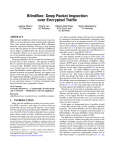Download detailed guideline for Lab1
Transcript
Lab1 : Lock Server
Introduction
To work correctly, the yfs servers need a locking service to coordinate updates to the file
system structures. In this lab, you'll implement a simple lock service.
The core logic of the lock service consists of two modules, the lock client and the lock server,
which communicate via RPCs. A client requests a specific lock from the lock server by sending an
acquire request. The lock server grants the requested lock to one client at a time. When a client is
done with the granted lock, it sends a release request to the server so the server can grant the lock
to another client (if any) waiting to acquire the lock.
In addition to implementing the lock service, you'll also augment the provided RPC library to
ensure at-most-once execution by eliminating duplicate RPC requests. Duplicate requests exist
because the RPC system must re-transmit lost RPCs in the face of lossy network connections and
such re-transmissions often lead to duplicate RPC delivery when the original request turns out not
to be lost.
Duplicate RPC delivery, when not handled properly, often violates application semantics.
Here's an example of duplicate RPCs causing incorrect lock server behavior. A client sends an
acquire request for lock x, the server grants the lock, the client releases the lock with a release
request, a duplicate RPC for the original acquire request then arrives at the server, the server grants
the lock again, but the client will never release the lock again since the second acquire is just a
duplicate. Such behavior is clearly incorrect.
Software
The files you will need for this and subsequent lab assignments in this course are distributed
using the Git version control system. To learn more about Git, take a look at the Git user's manual
http://www.kernel.org/pub/software/scm/git/docs/user-manual.html , or, if you are already
familiar with other version control systems, you may find this CS-oriented overview of Git useful
http://eagain.net/articles/git-for-computer-scientists/.
The URL for the course Git repository is http://csapp.cs.tsinghua.edu.cn/ds2013/yfs-class.git.
To install the files in your linux machine, you need to clone the course repository by running the
commands below.
mkdir ~/ds
cd ~/ds
git clone http://csapp.cs.tsinghua.edu.cn/ds2013/yfs-class.git lab
cd lab
You can also clone the course repository from the MIT 6.824 website. They are the same. Be
sure to get the most up-do-date version.
Git allows you to keep track of the changes you make to the code. For example, if you are
finished with one of the exercises, and want to checkpoint your progress, you can commit your
changes by running:
git commit –am ‘my solution for lab1 exercise9’
You can keep track of your changes by using the git diff command. Running git diff will display
the changes to your code since your last commit, and git diff origin/lab1 will display the changes
relative to the initial code supplied for this lab. Here, origin/lab1 is the name of the git branch with
the initial code you downloaded from our server for this assignment.
Getting started
We provide you with a skeleton RPC-based lock server, a lock client interface, a sample
application that uses the lock client interface, and a tester. Now compile and start up the lock server,
giving it a port number on which to listen to RPC requests. You'll need to choose a port number
that other programs aren't using. For example:
cd lab
make
./lock_server 3772
Now open a second terminal on the same machine and run lock_demo, giving it the port
number on which the server is listening:
cd lab
./lock_demo 3772
lock_demo asks the server for the number of times a particular lock has been acquired, using
the stat RPC that we have provided. In the skeleton code, this will always return 0. You can use it
as an example of how to add RPCs. You don't need to fix stat to report the actual number of
acquisitions of the given lock in this lab, but you may if you wish.
The lock client skeleton does not do anything yet for the acquire and release operations;
similarly, the lock server does not implement lock granting or releasing. Your job is to implement
this functionality in the server, and to arrange for the client to send RPCs to the server.
Your Job
Your first job is to implement a correct lock server assuming a perfect underlying network.
Correctness means obeying this invariant: at any point in time, there is at most one client holding
a lock with a given identifier.
We will use the program lock_tester to check the correctness invariant, i.e. whether the server
grants each lock just once at any given time, under a variety of conditions. You run lock_tester with
the same arguments as lock_demo. A successful run of lock_tester (with a correct lock server) will
look like this:
% ./lock_tester 3772
simple lock client
acquire a release a acquire a release a
acquire a acquire b release b release a
test2: client 0 acquire a release a
test2: client 2 acquire a release a
...
./lock_tester: passed all tests successfully
If your lock server isn't correct, lock_tester will print an error message. For example, if
lock_tester complains "error: server granted XXX twice", the problem is probably that lock_tester
sent two simultaneous requests for the same lock, and the server granted both requests. A correct
server would have granted the lock to just one client, waited for a release, and only then sent
granted the lock to the second client.
Your second job is to augment the RPC library to guarantee at-most-once execution. You can
tell the RPC library to simulate a lossy network by setting the environment variable RPC_LOSSY. If
you can pass both the RPC system tester and the lock_tester, you are done. Here's a successful run
of both testers:
% export RPC_LOSSY=0
% ./rpc/rpctest
simple test
...
rpctest OK
% killall lock_server
% export RPC_LOSSY=5
% ./lock_server 3722 &
% ./lock_tester 3772
simple lock client
acquire a release a acquire a release a
...
./lock_tester: passed all tests successfully
Your code must pass both ./rpc/rpctest and lock_tester; you should ensure it passes several
times in a row to guarantee there are no rare bugs. You should only make modifications on files
rpc.{cc,h}, lock_client.{cc,h}, lock_server.{cc,h} and lock_smain.cc. We will test your code with with
our own copy of the rest of the source files and testers. You are free to add new files to the directory
as long as the Makefile compiles them appropriately, but you should not need to.
For this lab, you will not have to worry about server failures or client failures. You also need
not be concerned about malicious or buggy applications.
Detailed Guidance
In principle, you can implement whatever design you like as long as it satisfies the
requirements in the "Your Job" section and passes the testers. In practice, you should follow the
detailed guidance below.
Step One: implement the lock_server assuming a perfect network
First, you should get the lock_server running correctly without worrying about duplicate RPCs.
Using the RPC system:
The RPC library's source code is in the subdirectory rpc/. A server uses the RPC library by
creating an RPC server object (rpcs) listening on a port and registering various RPC handlers (see
lock_smain.cc). A client creates a RPC client object (rpcc), asks for it to be connected to the
lock_server's address and port, and invokes RPC calls (see lock_client.cc).
Each RPC procedure is identified by a unique procedure number. We have defined the acquire
and release RPC numbers you will need in lock_protocol.h. You must register handlers for these
RPCs with the RPC server object (see lock_smain.cc).
You can learn how to use the RPC system by studying the stat call implementation in
lock_client and lock_server. RPC handlers have a standard interface with one to six request
arguments and a reply value implemented as a last reference argument. The handler also returns
an integer status code; the convention is to return zero for success and to return positive numbers
for various errors. If the RPC fails in the RPC library (e.g.timeouts), the RPC client gets a negative
return value instead. The various reasons for RPC failures in the RPC library are defined in rpc.h
under rpc_const.
The RPC system marshalls objects into a stream of bytes to transmit over the network and
unmarshalls them at the other end. Beware: the RPC library does not check that the data in an
arriving message have the expected type(s). If a client sends one type and the server is expecting
a different type, something bad will happen. You should check that the client's RPC call function
sends types that are the same as those expected by the corresponding server handler function.
The RPC library provides marshall/unmarshall methods for standard C++ objects such as
std::string, int, and char (see file rpc.cc). If your RPC call includes different types of objects as
arguments, you must provide your own marshalling method. You should be able to complete this
lab with existing marshall/unmarshall methods.
Implementing the lock server
The lock server can manage many distinct locks. Each lock is identified by an integer of type
lock_protocol::lockid_t. The set of locks is open-ended: if a client asks for a lock that the server has
never seen before, the server should create the lock and grant it to the client. When multiple clients
request the same lock, the lock server must grant the lock to one client at a time.
You will need to modify the lock server skeleton implementation in files lock_server.{cc,h} to
accept acquire/release RPCs from the lock client, and to keep track of the state of the locks. Here
is our suggested implementation plan.
On the server, a lock can be in one of two states;
free: no clients own the client
locked: some client owns the lock
The RPC handler for acquire should first check if the lock is locked, and if so, the handler should
block until the lock is free. When the lock is free, acquire changes its state to locked, then returns
to the client, which indicates that the client now has the lock. The value r returned by acquire
doesn't matter. The handler for release should change the lock state to free, and notify any threads
that are waiting for the lock.
Consider using the C++ STL (Standard Template Library) std::map class to hold the table of lock
states.
Implementing the lock client:
The class lock_client is a client-side interface to the lock server (found in files
lock_client.{cc,h}). The interface provides acquire() and release() functions that should send and
receive RPCs. Multiple threads in the client program can use the same lock_client object and
request the same lock. See lock_demo.cc for an example of how an application uses the interface.
lock_client::acquire must not return until it has acquired the requested lock.
Handling multi-thread concurrency:
Both lock_client and lock_server's functions will be invoked by multiple threads concurrently.
On the lock server side, the RPC library keeps a thread pool and invokes the RPC handler using one
of the idle threads in the pool. On the lock client side, many different threads might also call
lock_client's acquire() and release() functions concurrently.
You should use pthread mutexes to guard uses of data that is shared among threads. You
should use pthread condition variables so that the lock server acquire handler can wait for a lock.
The general tips contain a link to information about pthreads, mutexes, and condition variables.
Threads should wait on a condition variable inside a loop that checks the boolean condition
on which the thread is waiting. This protects the thread from spurious wake-ups from the
pthread_cond_wait() and pthread_cond_timedwait() functions.
Use a simple mutex scheme: a single pthreads mutex for all of lock_server. You don't really
need (for example) a mutex per lock, though such a setup can be made to work. Using "coarsegranularity" mutexes will simplify your code.
Step two: Implement at-most-once delivery in RPC
The RPC code we provide you has a complete client implementation of at-most-once delivery:
the client code times out while waiting for a response, re-sends the request, and accompanies each
request with information the server will need for its part of at-most-once delivery. However, the
code is missing some of the server at-most-once code, in particular the implementation of the
functions rpcs::checkduplicate_and_update and rpcs::add_reply. It is your job to implement those
two functions.
After your lock server has passed lock_tester, test it with a simulated lossy network: type
"export RPC_LOSSY=5", restart your lock_server, and try lock_tester again. Very likely you will see
the lock_tester fail or hang indefinitely. Try to understand exactly why your lock_tester fails when
re-transmissions cause duplicate RPC delivery.
Skim the RPC source code in rpc/rpc.{cc,h} and try to grasp the overall structure of the RPC
library as much as possible first by yourself before proceeding. rpc.cc already contains some of the
code required to cope with duplicate requests; your job will be to complete that code.
The rpcc class manages RPC calls for clients. At its core lies the rpcc::call1 function, which
accepts a marshalled RPC request for transmission to the RPC server. call1 attaches additional RPC
fields to each marshalled request:
// add RPC fields before the RPC request data
req_header h(ca.xid, proc, clt_nonce_, srv_nonce_, xid_rep_window_.front());
req.pack_req_header(h);
What's the purpose for each field in req_header? (Hint: many of them are going to help you
implement at-most-once delivery.) After call1 has finished preparing the final RPC request, it sits
in a "while(1)" loop to (repeatedly) update the timeout value for the next retransmission and waits
for the corresponding RPC reply or timeout to happen. Also, if the underlying (TCP) connection to
the server fails, rpcc automatically re-connects to the server again (in function get_refconn) in
order to retransmit.
The rpcs class manages RPC calls for the server. When a connection receives an RPC request,
it calls rpcs::got_pdu to dispatch the request to a thread from the pool. The thread pool (class
ThrPool) consists of a fixed number of threads that call rpcs::dispatch to dispatch an RPC request
to the relevant registered RPC handler. rpcs::dispatch extracts RPC fields from the request,
including the RPC procedure number which is used to find the corresponding handler. The header
fields also provide sufficient information for you to ensure that the server eliminates all duplicate
requests.
Question: The partial lock server we provide you uses "blocking" RPC handlers that sometimes
wait (for lock releases). How many concurrent "blocking" lock acquire requests can the server
handle? (Hint: our implementation of rpcs currently uses a thread pool of 10 threads).
How to ensure at-most-once delivery? A strawman approach is to make the server remember
all unique RPCs ever received. Each unique RPC is identified by both its xid (unique across a client
instance) and clt_nonce (unique across all client instances). In addition to the RPC ids, the server
must also remember the original return value for each RPC so that the server can re-send it in
response to a duplicate request. This strawman guarantees at-most-once, but is not ideal since the
memory holding the RPC ids and replies grows indefinitely. A better alternative is to use a sliding
window of remembered RPCs at the server. Such an approach requires the client to generate xid
in a strict sequence, i.e. 0, 1, 2, 3... When can the server safely forget about a received RPC and its
response, i.e. slide the window forward? What if a retransmitted request arrives while the server
is still processing the original request?
Once you figure out the basic design for at-most-once delivery, go ahead and implement your
design in rpc.cc and (if needed) rpc.h; you should not need to modify any other files. You need to
add code in two places. First, rpcs::checkduplicate_and_update should 1) check if a request is a
duplicate and return information about the remembered reply if it is, 2) remember that a new
request has arrived if it is not a duplicate, and 3) trim the window of remembered requests and
reply values. Second, rpcs::add_reply should remember the RPC reply values for an RPC call that
the server has completed. You should store the remembered RPC reply values in
rpcs::reply_window_, declared in rpc.h.
After you are done with step two, test your RPC implementation with ./rpc/rpctest and
RPC_LOSSY set to 0 ("export RPC_LOSSY=0"). Make sure ./rpc/rpctest passes all tests. Once your
RPC implementation passes all these tests, test your lock server again in a lossy environment by
restarting your lock_server and lock_tester after setting RPC_LOSSY to 5 ("export RPC_LOSSY=5").
The RPC_LOSSY environment variable must be set for both lock_server and lock_tester.
Handin procedure
E-mail your code as a gzipped tar file to Teacher [email protected] and TA
[email protected] by the deadline mentioned in the course website. Do not send to the 6.824
email, do not bother them if you just follow the guideline from their web.
tar czvf your-student-id-your-name-lab1.tar.gz lab/
Please remember to change to your own name and id. Attach the file to an email and send it
to the address mentioned above. Your credit will based on your codes (passes the tests) and the
interview with the TA and the teacher.




























